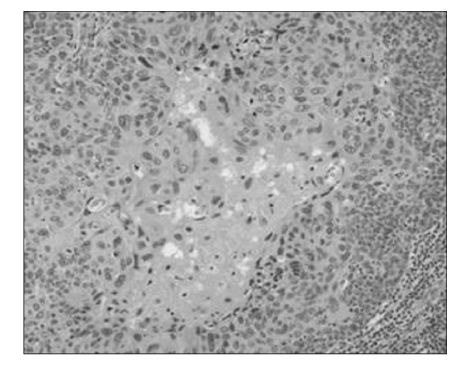J Gynecol Oncol.
2008 Jun;19(2):145-149. 10.3802/jgo.2008.19.2.145.
A case of inguinal lymph node squamous cell carcinoma of unknown origin, accompanied with carcinoma in situ of cervix
- Affiliations
-
- 1Department of Obstetrics and Gynecology, College of Medicine, The Catholic University of Korea, Seoul, Korea. hursy@catholic.ac.kr
- 2Department of Pathology, College of Medicine, The Catholic University of Korea, Seoul, Korea.
- KMID: 2129916
- DOI: http://doi.org/10.3802/jgo.2008.19.2.145
Abstract
- Metastatic Cancer of Unknown Primary Site (CUP) accounts for approximately 3-5% of all malignant neoplasms. CUP represents a heterogeneous group of metastatic tumors for which no primary site can be detected following a thorough medical history, careful clinical examination, and extensive diagnostic work-up. Several authors have reported poor prognosis of this malignancy, because there is no consensus on diagnostic guidelines and optimal therapy. Historically, chemotherapy has been the cornerstone of treatment for patients with CUP. We experienced a case of inguinal lymph node squamous cell carcinoma of unknown origin, accompanied with carcinoma in situ of the cervix. We report this case with a brief review of the literatures.
MeSH Terms
Figure
Reference
-
1. Pavlidis N, Briasoulis E, Hainsworth J, Greco FA. Diagnostic and therapeutic management of cancer of an unknown primary. Eur J Cancer. 2003. 39:1990–2005.2. Hainsworth JD, Greco FA. Management of patients with cancer of unknown primary site. Oncology. 2000. 14:563–574.3. Holmes FF, Fouts TL. Metastatic cancer of unknown primary site. Cancer. 1970. 26:816–820.4. Blaszyk H, Hartmann A, Bjornsson J. Cancer of unknown primary: clinicopathologic correlations. APMIS. 2003. 111:1089–1094.5. Zaren HA, Copeland EM 3rd. Inguinal node metastases. Cancer. 1978. 41:919–923.6. Guarischi A, Keane TJ, Elhakim T. Metastatic inguinal nodes from an unknown primary neoplasm. A review of 56 cases. Cancer. 1987. 59:572–577.7. Burbos N, Blanas K, Epurescu SD, Lonsdale R, Nieto JJ. Unknown primary site of serous papillary adenocarcinoma involving inguinal, iliac and obturator lymph nodes co-existing with endometrial adenocarcinoma. J Obstet Gynaecol. 2007. 27:542–543.8. Frost P, Raber MN, Abbruzzese JL. Unknown primary tumors as a unique clinical and biologic entity: A hypotheis. Cancer Bull. 1989. 41:139–141.9. Abbruzzese JL, Abbruzzese MC, Lenzi R, Hess KR, Raber MN. Analysis of a diagnostic strategy for patients with suspected tumors of unknown origin. J Clin Oncol. 1995. 13:2094–2103.10. Pavlidis N, Kalef-Ezra J, Briassoulis E, Skarlos D, Kosmidis P, Saferiadis K, et al. Evaluation of six tumor markers in patients with carcinoma of unknown primary. Med Pediatr Oncol. 1994. 22:162–167.11. Petrović D, Muzikravić L, Jovanović D. Metastases of unknown origin-principles of diagnosis and treatment. Med Pregl. 2007. 60:29–36.12. Hillen HF. Unknown primary tumours. Postgrad Med J. 2000. 76:690–693.13. Abbruzzese JL, Abbruzzese MC, Lenzi R, Hess KR, Raber MN. Analysis of a diagnostic strategy for patients with suspected tumors of unknown origin. J Clin Oncol. 1995. 13:2094–2103.14. Pavlidis N, Kosmidis P, Skarlos D, Briassoulis E, Beer M, Theoharis D, et al. Subsets of tumors responsive to cisplatin or carboplatin combination in patients with carcinoma of unknown primary site. Ann Oncol. 1992. 3:631–634.15. Greco FA, Hainsworth JD. Poorly differentiated carcinoma or adenocarcinoma of unknown primary site: Long-term results with cisplatin-based chemotherapy. Semin Oncol. 1994. 21(5):Suppl 12. 77–82.16. Greco FA, Hainsworth JD. The evolving role of paclitaxel for patients with carcinoma of unknown primary site. Semin Oncol. 1999. 26(1):Suppl 2. 129–133.17. Greco FA, Erland JB, Morrissey LH, Burris HA 3rd, Hermann RC, Steis R, et al. Carcinoma of unknown primary site: Phase II trials with docetaxel plus cisplatin or carboplatin. Ann Oncol. 2000. 11:211–215.18. Greco FA, Burris HA 3rd, Erland JB, Gray JR, Kalman LA, Schreeder MT, et al. Carcinoma of unknown primary site: Long term follow-up after treatment with paclitaxel, carboplatin and etoposide. Cancer. 2000. 89:2655–2660.19. Casciato DA, Tabbarah HJ. Haskell CM, editor. Metastases on unknown origin. Cancer Treatment. 1990. 3rd ed. Philadelphia: WB Saunders;798–814.20. Greco FA, Hainsworth JD. De Vita TV, Hellman S, Rosenberg SA, editors. Cancer of unknown primary site. Cancer: Principles and Practice of Oncology. 1997. 4th ed. Philadelphia: J.B. Lippincott Co;2423–2443.
- Full Text Links
- Actions
-
Cited
- CITED
-
- Close
- Share
- Similar articles
-
- A Case of Squamous Cell Carcinoma of the Scrotum
- Squamous Cell Carcinoma of the Cervix with Intraepithelial Extension to the Endometrium: A Case Report
- A Case of Malignant Melanoma Associated with Squamous Cell Carcinoma
- Primary Squamous Cell Carcinoma of the Endometrium
- A Case of Primary Squamous Cell Carcinoma of Sigmoid Colon






